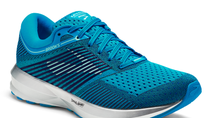Media
What’s in the new Brooks Running shoe’s midsole?
The athletic footwear company expands its midsole material selection by going where its performance running shoe has never gone before.

Brooks Running has no misconceptions about what sort of company it is. “We’re a very small brand, we’re not Nike or Adidas,” said Zach Boteilho, Senior Innovation Developer, Brooks Running.
Nevertheless, while other shoe brands continue working on that one shoe that does everything, which could prove challenging with current-day technology, Brooks decided to go in a different direction. The sneaker company created two very distinct shoes, giving runners a choice in experience between soft, protective cushioning —reflected in its Glycerin shoe, and energy return cushioning—in its latest launch—the new Levitate with DNA AMP. Each of these shoes is now created with a different type of midsole material. (The midsole is considered the most important part of the shoe in terms of cushioning and stability).
Brooks’ Glycerin midsole is made with what most athletic shoes use—ethylene-vinyl acetate (EVA), a man-made material that is considered foam, known for its low density and lightness that’s been favored by the industry for 40 years. While this shoe is sure to feel lighter on your feet, over time, a footwear product made from EVA could lose its cushioning and support. That’s where the Levitate shoe comes in—its midsole is made from polyurethane (PU). BASF created this organic polymer, made from a blend of the company’s Elastopan Sports Light Material, specifically for Brooks, which naturally expands, returning energy as force is applied. Aside from providing the most high-energy return of leading performance running shoes, PU midsoles are known for their longevity and durability since they do not compress over time and have no memory.
By refining the formula and making modifications to polyurethane on a molecular level, the DNA AMP midsole offers enhanced comfort and durability and provides runners with the most energy return of leading performance running shoes, per Brooks’ test method.
“There are two components to a step—the impact with the ground and the other is the push-off,” explained Chau Nguyen, Market Segment Manager, Footwear, PM North America, BASF, who worked closely with Brooks on the project. “When you are running, energy is absorbed each time your foot strikes the ground. In regular shoes a lot of the energy is converted to heat. Sometimes a runner can feel warmth of the shoe sole after a tough work out. In this shoe, the energy is stored, like a coiled spring, and it is released as you push off the ground. It literally puts spring in your step, and it can help you carve a few seconds off.”

Creating a shoe with a different material than an EVA midsole is a first for Brooks and for its performance running shoe, but a way for the brand to differentiate itself from the rest.
“Our feeling is, EVA’s going to top out in the innovation sense. There’s not a lot of advance happening with it right now,” Boteilho added. “We’re not going to build one shoe that does everything. We’re going to provide two different running feelings and experiences that runners will be able to choose.”
With the new Levitate shoe launch end of September, Brooks intends to create half of its shoes with BASF’s PU material going forward—a big step for the footwear company, which has previously used only EVA in its midsoles.
“Each brand wants to tell a story and differentiate themselves. It’s important for Brooks for the new material to position them as a game changer or leader,” Nguyen added.
The Brooks Levitate with DNA AMP is available for $150 in two colors for women and two colors for men.
To read more about Brooks Running’s Levitate launch in NYC, click here.
Brooks Running was recently a guest at a BASF Town Hall in Wyandotte, Michigan. There, Boteilho explained the concept behind its new Levitate with DNA AMP running shoe. (See video below).
Published by Anna Spiewak.
For media inquiries or to repurpose this article, contact Lisa Brown.